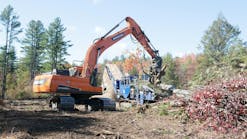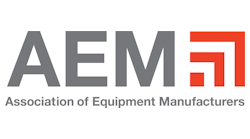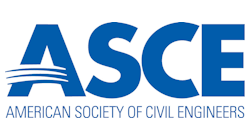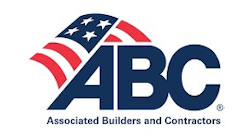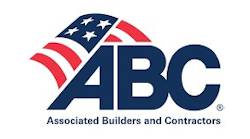Quick. If you’re a contractor who requires employees to work in excavations, what are the only two situations in which OSHA (Occupational Safety and Health Administration) will give you a pass on providing cave-in protection?
The answer is: 1) If the excavation is made in “stable rock” (which OSHA defines as “natural solid mineral material that can be excavated with vertical sides and will remain intact while exposed”); or 2) if the excavation is fewer than 5 feet deep and “examination of the ground by a competent person provides no indication of a potential cave-in.” But the implication is clear-if you’re not sure about the soil, then you need protection even in shallow excavations.
Cave-in protection can take two forms: 1) walls that slope away from the bottom of the excavation-and OSHA has definite rules for the angles involved; or 2) shoring or shielding. Shoring systems are mechanical structures-made of metal or timber-that are designed to prevent cave-ins; shielding systems are mechanical devices designed to withstand a cave-in and thus protect workers, such as trench boxes. Although OSHA rules are clear and legally binding, they are often violated.
“Given the potential hazards to workers and the liability issues involved, I’m still taken aback by the number of contractors who ignore OSHA and place their employees at risk,” says Taylor Clark, underground specialist at Cat dealer MacAllister Machinery, based in Indianapolis, IN. “Today on my way back from lunch, for instance, I saw five guys working in a manhole excavation with no protection. The contractor obviously doesn’t know-or doesn’t care-that manhole shields are made specifically for this application.”
The Good Guys
Although Clark doesn’t win every battle to promote excavation protection, he does number among his customers responsible contractors who consider protection as much a moral obligation to workers as a legal responsibility. These are people who think through the alternatives and choose a method that best suits the project, says Clark, such as Josh Vancel and Howard McClanahan.
The Slide Rail system is installed from the top down. The second and third set of panels is slightly forward of the set above, each set in a different track.
“If you’re not using a trench box, then you’re required to bank back the walls of your trench so that it can’t cave in on your laborers,” says Vancel, project coordinator for Poindexter Excavating, a site-development contractor based in Indianapolis. “Sloping back takes time and fuel, and you end up moving a lot more material than if you’d just used a trench box from the start and kept the trench walls vertical.”
The amount of dirt to be moved in order to satisfy OSHA standards for sloped walls can, indeed, be significant. The material must be stockpiled, then excavated a second time and transported to the site when backfilling. Although sloping can be a practical method in some instances, shoring or shielding most often is a more efficient solution.
Commercially available shoring and shielding systems, says Clark, include trench boxes of all sizes; trench shields fitted with one or two “high-clearance-arches” to accommodate large-diameter pipe; manhole shields; reduced-weight aluminum shielding; vertical hydraulic shoring; and specialty shoring, such as the Pro-Tec Slide Rail system. The latter system was the choice for the deepest, confined-space excavation on the site of a new wastewater-treatment plant in Columbus, IN, where McClanahan, a supervisor for Bowen Engineering (also based in Indianapolis), is overseeing the project.
Columbus Tomorrow
According to Dale Langferman, manager of finance and business for the city of Columbus, the city’s “Columbus Tomorrow” project is an $80-million overhaul of the city’s sanitary-sewer system, which includes a new $42 million treatment plant. The new facility, scheduled for completion in December 2011, will have expanded capacity and will use more efficient processes, says Mike Meyer, P.E., an engineer with Strand Associates, the lead firm in a design partnership that includes CH2M Hill and Christopher B. Burke Engineering.
The old plant uses the fixed-film process of rotating biological contactors, says Meyer, but the new plant will use the Cannibal system (a Siemens technology), which considerably reduces the volume of solids remaining after treatment. The new plant also is designed to be as “green” as possible, says Langferman, employing, for example, a low-energy ultraviolet process to disinfect effluent and a system to capture heat from processes to warm onsite buildings.
From McClanahan’s point of view, the 40-acre project that started on June 15 entails moving 92,000 cubic yards of dirt-of which nearly 65,000 cubic yards were moved by the end of August, despite a month of rain delay; pouring 28,000 cubic yards of concrete; placing 2,200 feet of 72-inch-diameter pipe to carry effluent to the White River; and building 17 structures-among them four clarifiers, each 140 feet in diameter with 16-foot-tall concrete walls.
Slide-Rail Shoring
Another of the structures on the treatment-plant site is the recycling-pump station, which requires an excavation approximately 23 feet deep, 40 feet long, and 20 feet wide. Practical choices for protection, says McClanahan, were the Pro-Tec Slide Rail shoring system and tight sheeting, consisting of 3-foot-wide vertical interlocking panels driven into the ground against the excavation walls.
The slide-rail system was chosen, he says, because it could be installed more quickly than sheeting and, thus, was more economical for the relatively short duration of the pump-station project. Had the project required a longer time for completion, says McClanahan, then sheeting may have been more economical. In either instance, the well-point system Bowen installed to dewater the site 3 feet below the proposed excavation would have been required.
According to MacAllister’s Clark, slide-rail shoring is a rented system, but not an off-the-shelf item. The distributor and manufacturer work together with the contractor to design each system for its specific application, he says, and a trained advisor from the distributor or Pro-Tec oversees installation.
The slide-rail system in Columbus is a “triple-rail” type, which means the system’s 28-foot-tall corner posts have three rails (or tracks) for engaging three sets of fabricated-steel panels that measure 8 feet tall and 20 feet long for the Columbus project. The tracks in the corner posts are flanged and interlock with the T-shaped side edges of the panels.
During installation, an excavator first dug a pilot cut for the pump station to an approximate depth of 8 feet. Then, in sequence, the machine placed a panel against a short wall and swung in a corner post, allowing the post’s outer track (closest to the wall) to slide over the edge of the panel. A second panel was inserted into the corner post’s adjacent outer track to form a right angle with the long side of the excavation.
Two 20-foot panels were required on the long side of the excavation and were joined with an intermediate post (a spreader post). This post-and-panel sequence continued until the perimeter of the excavation was walled in. As the excavator continued to dig, it also pushed down the posts and the six panels until the top edges of the panels were level with the original starting grade.
As the pit became deeper, the excavator inserted a second set of panels into the second track of the posts. The machine again pushed down the posts and the second set of panels until the top edges of the panels were even with the bottom edges of the first set. This digging and pushing process was repeated with a third set of panels-inserted into the remaining (innermost) track-until the top edges of the last set of panels were even with the bottom edges of the second set.
To keep the two spreader posts vertical (these posts, remember, are facing each other across the long sides of the excavation), two horizontal spreader beams were placed between them. Actually, the two spreader beams attach to a pair of short, vertical roller beams, and this entire rectangular structure (roller frame) moves up and down on rollers between the two spreader posts, allowing increased height if large components must be placed in the excavation.
Howard McClanahan, left, superintendent for Bowen Engineering, prime contractor for the Columbus treatment plant, explains project details to Amber Santor, Caterpillar Global Marketing Support, and Taylor Clark, underground specialist for Cat dealer MacAllister Machinery.
Looking down a corner post shows the flanged design of the slide-rail tracks and the T-shaped edge of the panels. The design allows the two components to interlock.
Shoring Benefits
According to Clark, who assisted in the design and installation of the Columbus system, the slide-rail system is available with single-, double- and triple-track posts (corner and spreader) to suit the depth of the excavation. The system can be used in excavations deeper than the triple-track could accommodate top to bottom, he says, if the shoring is installed at the bottom of the excavation and the walls then sloped back at a 1-to-1 ratio from 18 inches below the top of the shoring.
The slide-rail system also is modular in design, says Clark, with panels available in lengths from 6 feet to 24 feet in 2-foot increments. An unlimited number of “bays” can be constructed, he says, by connecting panels of appropriate length with spreader posts. In very long excavations, he says, the contractor can “leap-frog” the bays to reduce the number of posts and panels required.
Also, if the rolling spreader frames (between spreader posts) pose an obstruction to placing large items in the excavation, such as long tanks, they can be removed after “walers” (heavy, engineer-approved I-beams) are laid around the perimeter of the excavation and secured to the posts with large U-bolts. In particularly wide excavations, these “clear-span” installations (without roller frames) may require a “sacrificial” beam between the lower ends of certain spreader posts for rigidity. The beam is sacrificial because it will be buried beneath whatever is installed in the pit.
When a slide-rail excavation is ready for backfilling, says Clark, the modular design of the system allows the panels to be removed in reverse order of installation, that is, the lower-most panels come out first. This sequence, he says, permits the lower portions of the excavation to be safely backfilled-while the rest of the excavation remains solidly behind the upper panels.
The modular design is particularly advantageous during removal, says Clark, because the great inward pressure that excavation walls exert at depths of 15, 20, or 30 feet below grade make a large trench shield extremely difficult to remove after it has been in place for several days (or even several hours).
“Slide-rail eliminates this problem,” says Clark, “because the modular design allows for smaller parts and less surface area that has to accept loading at these great depths. Three 10-foot-long slide-rail panels can be effortlessly removed with, say, a Cat 330 excavator, even after a month-long project. Try using the same machine to pull out an 8-foot-by-30-foot trench box that has been sitting 20 feet deep just overnight in a rain storm-the pressure would make it impossible.”
Yet another advantage of the shoring system, compared with sheeting, he says, is its ability to be used in areas where vibration from driving sheeting would be objectionable or dangerous.
“Of course, in some applications, sheeting is the most practical system,” says Clark, “but when either sheeting or the slide-rail system will work, it’s been my experience that slide rail goes in much faster and proves more economical.”
